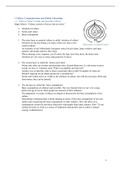Samenvatting
Samenvatting Intercultural Sensitivity, ISBN: 9789023256885 International Hospitality
Dit is een samenvatting van alle stof die je moet kennen voor je international hospitality tentamen, een samenvatting van het gehele boek. Alle informatie is duidelijk en direct uitgelegd en er zijn plaatjes gebruikt om het nog duidelijker te maken.
[Meer zien]






